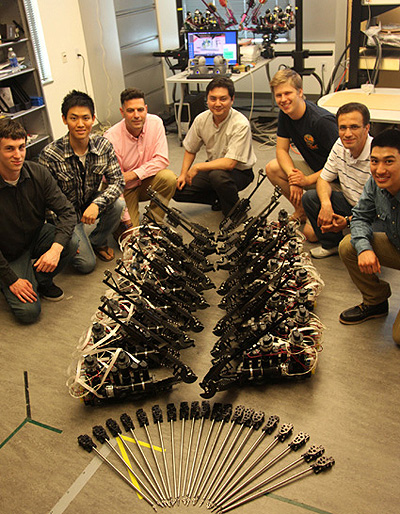Campus News
‘Open-source’ robotic surgery platform going to top medical research labs
Robotics experts at UCSC and UW have built seven advanced robotic surgery systems for use by major medical research laboratories.

Robotics experts at UC Santa Cruz and the University of Washington (UW) have completed a set of seven advanced robotic surgery systems for use by major medical research laboratories throughout the United States. After a round of final tests, five of the systems will be shipped to medical robotics researchers at Harvard University, Johns Hopkins University, University of Nebraska, UC Berkeley, and UCLA, while the other two systems will remain at UC Santa Cruz and UW.
“We decided to follow an open-source model, because if all of these labs have a common research platform for doing robotic surgery, the whole field will be able to advance more quickly,” said Jacob Rosen, associate professor of computer engineering in the Baskin School of Engineering at UCSC and principal investigator on the project.
Rosen and Blake Hannaford, director of the UW Biorobotics Laboratory, lead the research groups that developed the Raven II robotic surgery system and its predecessor, Raven I. A grant from the National Science Foundation funded their work to create seven identical Raven II systems. Hannaford said the systems will be shipped out from UW by the end of January. After they are delivered and installed, all seven systems will be networked together over the Internet for collaborative experiments.
Robotic surgery has the potential to enable new surgical procedures that are less invasive than existing techniques. For some procedures, such as prostate surgery, the use of surgical robots is already standard practice. In addition, telesurgery, in which the surgeon operates a robotic system from a remote location, offers the potential to provide better access to expert care in remote areas and the developing world. Having a network of laboratories working on a common platform will make it easier for researchers to share software, replicate experiments, and collaborate in other ways.
Even though it meant giving competing laboratories the tools that had taken them years to develop, Rosen and Hannaford decided to share the Raven II because it seemed like the best way to move the field forward. “These are the leading labs in the nation in the field of surgical robotics, and with everyone working on the same platform we can more easily share new developments and innovations,” Hannaford said.
According to Rosen, most research on surgical robotics in the United States has focused on developing new software for various commercially available robotic systems. “Academic researchers have had limited access to these proprietary systems. We are changing that by providing high-quality hardware developed within academia. Each lab will start with an identical, fully-operational system, but they can change the hardware and software and share new developments and algorithms, while retaining intellectual property rights for their own innovations,” Rosen said.
The Raven II includes a surgical robot with two robotic arms, a camera for viewing the operational field, and a surgeon-interface system for remote operation of the robot. The system is powerful and precise enough to support research on advanced robotic surgery techniques, including online telesurgery.
In addition to Rosen and Hannaford, UCSC postdoctoral researchers Daniel Glozman and Ji Ma, along with a group of dedicated undergraduate students working in Rosen’s Bionics Lab, played a key role in developing the Raven II. Rosen and Glozman have also developed a Raven IV surgical robotics system, which includes four robotic arms and two cameras. The system enables collaboration between two surgeons working from separate locations and connected over the Internet.